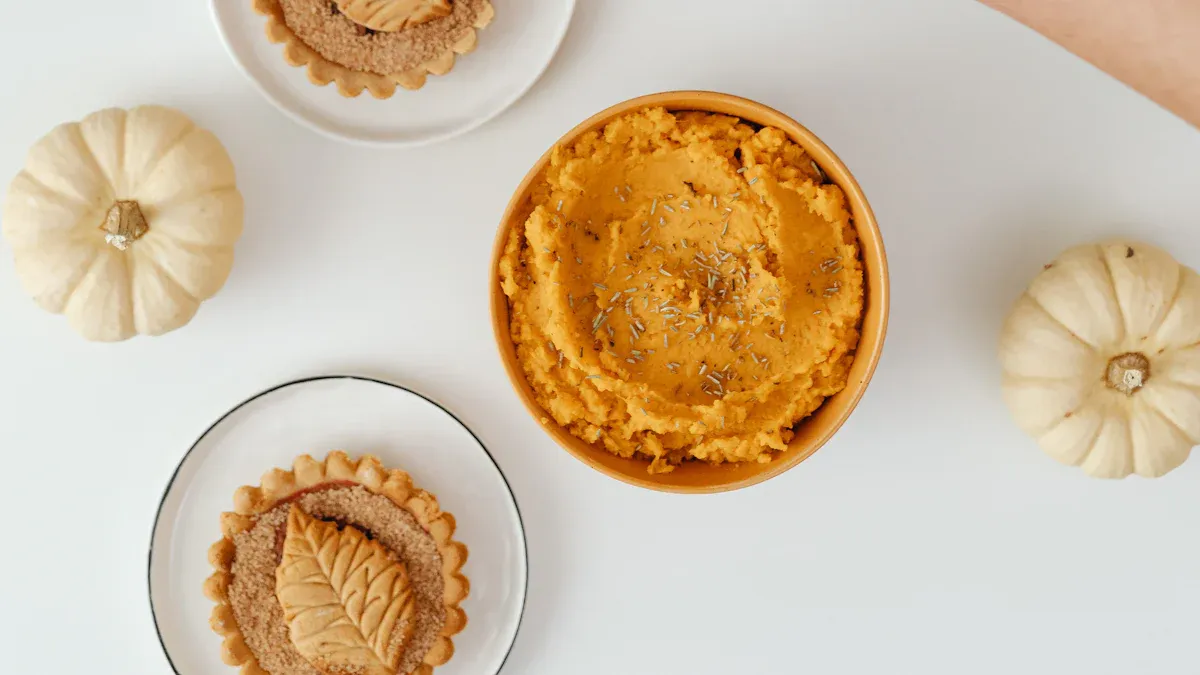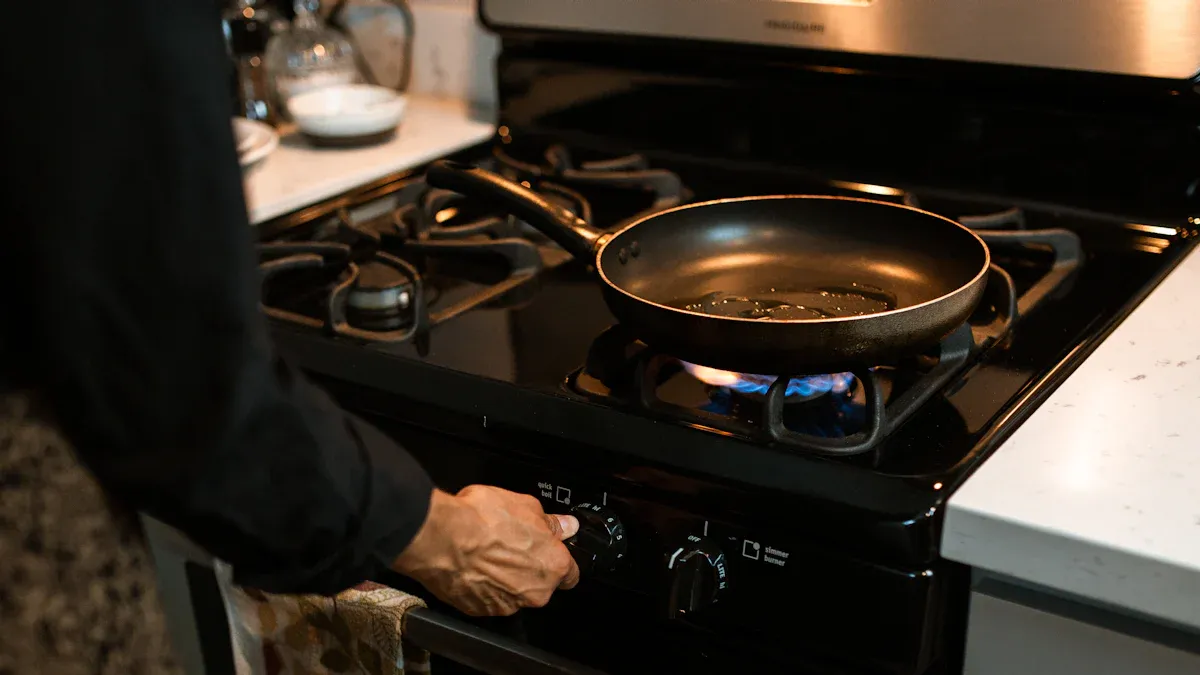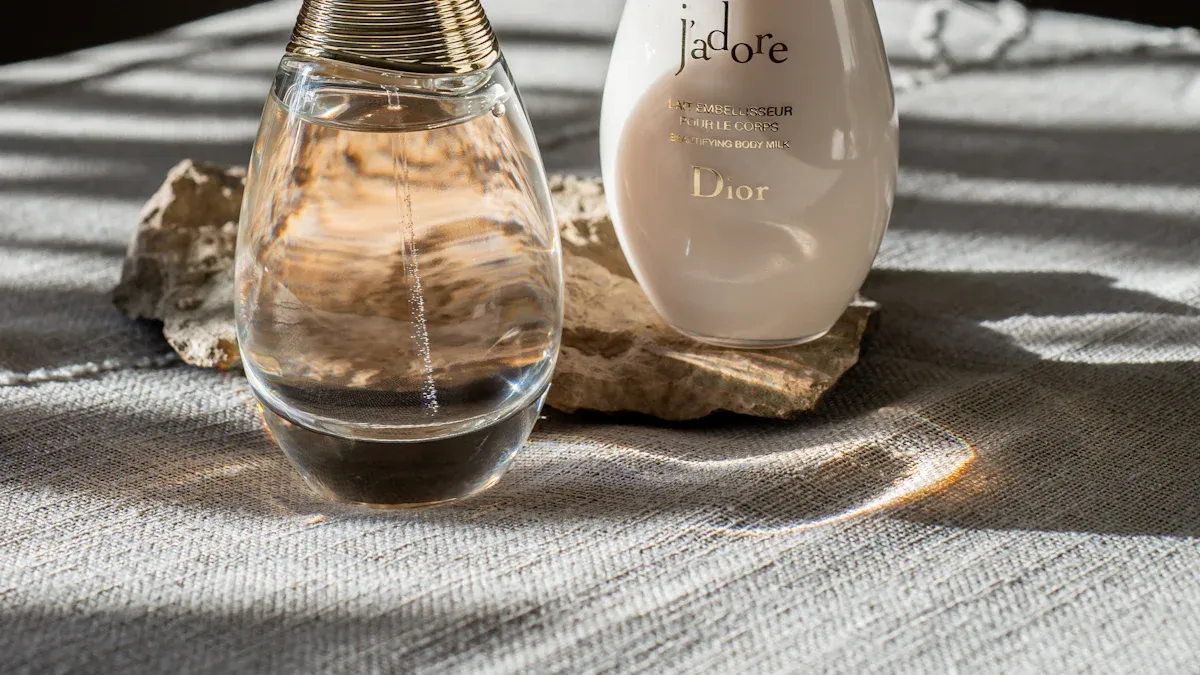
Cooking a turkey might seem like a daunting task, but ensuring it’s cooked to the right temperature makes it both easy and safe. You should always put the thermometer in the turkey, specifically in the thickest part of the breast or thigh. Be sure to avoid the bone, gristle, or the pan, as these can lead to inaccurate readings. Why is this important? It’s all about ensuring food safety and achieving the best flavor!
According to the USDA, turkey must reach an internal temperature of at least 165ºF to be safe to eat. Roasting it at 325ºF to 350ºF ensures even cooking. These aren’t just numbers—they’re the key to a juicy, perfectly cooked turkey.
By remembering to put the thermometer in the turkey correctly, you’ll guarantee it’s ready to serve and delicious every single time.
Tools for Checking a Turkey’s Temperature
Cooking a turkey is easier with the right tools. Let’s explore different thermometers and what makes a good one.
Types of Thermometers for Turkey
Not all thermometers work the same! Some are quicker, more precise, or simpler to use. Here’s a comparison of two great options recommended by experts:
Tool | Caractéristiques |
|---|---|
ThermoWorks Thermapen ONE | Fast, accurate readings, long probe, auto backlight |
ThermoWorks ThermoPop 2 | Affordable, bright screen, protective cap on probe |
I prefer the Thermapen ONE because it’s fast and precise. But if you want to save money, the ThermoPop 2 is a great pick. Both will help you cook your turkey perfectly!
Features of a Good Meat Thermometer
When choosing a thermometer, look for these important features:
⏱️ Quick readings: It should show the temperature in under 10 seconds. Waiting too long can cool the turkey!
📏 Long probe: Longer probes are better for big meats like turkey. They help you check the thickest parts safely.
💡 Clear display: Pick one with a bright screen or large numbers. It’s even better if you can read it without opening the oven.
🔥 Leave-in option: Some thermometers stay in the turkey while it cooks. This makes checking the temperature super easy.
Easy-to-use thermometers are also important. Wireless ones or those with simple buttons make cooking stress-free. With the right thermometer, cooking turkey becomes a breeze!
Where to Put a Thermometer in a Turkey

Knowing the right spot for the thermometer is key. It helps you cook the turkey safely and perfectly. Let’s look at the best places to check the temperature.
Thickest Part of the Breast
The thickest part of the breast gives the most accurate reading. This area cooks slower, so it’s the safest spot to check. Always aim for the center of the breast, not the thinner edges.
Here’s a tip: Push the thermometer straight into the thickest part. Avoid touching any bone or gristle. Bones heat up faster and can give a wrong reading. Studies show this placement ensures the turkey reaches 165°F, the safe temperature.
Temperature Spot | Why It’s Important |
|---|---|
Best for safe and accurate readings. | |
Innermost part of the thigh | Helps confirm the turkey is cooked. |
Innermost part of the wing | Completes the temperature check. |
Innermost Part of the Thigh
The innermost thigh is another important place to check. This part is dense and takes longer to cook. Insert the thermometer sideways into the thickest part, avoiding the bone.
Experts recommend checking the thigh because it’s one of the last spots to reach 165°F. If this area is at the right temperature, your turkey is fully cooked.
Preuves | Details |
|---|---|
Internal Temperature Rule | Turkey must reach 165°F in three spots: breast, thigh, and wing. |
Food Thermometer Use | A thermometer ensures the turkey is safe to eat. |
Avoiding Bone and Gristle
Avoiding bone and gristle is very important. Bones heat faster and can give a false high reading. Gristle doesn’t heat well and can give a false low reading.
Here’s what to do: Insert the thermometer carefully into the meat. Stay away from hard or rubbery spots. This way, you’ll get the real temperature of the turkey.
🦴 Keep the thermometer away from bones to avoid wrong readings.
🍖 Place the probe in the meat, not near gristle.
🥘 Don’t let the thermometer touch the pan, as it can affect results.
Follow these tips to get accurate readings and a perfectly cooked turkey every time.
Step-by-Step Guide to Put Thermometer in Turkey
Preparing the Turkey
Before you even think about where to put a thermometer in a turkey, you need to prep it properly. This step ensures the turkey cooks evenly and tastes amazing. Here’s my go-to process:
🛒 Buy the right size turkey: Plan for about 1 pound per person. If it’s frozen, let it thaw in the fridge (1 day for every 4 pounds).
🦃 Unwrap and clean: The night before cooking, unwrap the turkey, remove the neck and giblets, and rinse it with cool water.
🧂 Season and dry: Pat the turkey dry with paper towels, sprinkle it with salt, and leave it uncovered in the fridge overnight. This helps the skin crisp up.
⏰ Bring to room temperature: Take the turkey out of the fridge an hour before cooking. This step ensures even cooking.
🔥 Preheat and prep: Preheat your oven to 400°F and get your roasting pan ready.
🧈 Butter and season: Rub butter all over the turkey, season with salt and pepper, and stuff the cavity with onion, lemon, garlic, and herbs.
🪢 Tie and protect: Tie the drumsticks with butcher’s twine and cover the ends with foil to prevent overcooking.
Once your turkey is prepped, you’re ready to insert the thermometer and start roasting!
Inserting the Thermometer in the Breast
The thickest part of the breast is the best spot to check the turkey’s internal temperature. This area cooks slower than the rest, so it’s the most reliable place to put the probe.
Insert the thermometer deep into the thickest part of the breast. Make sure it’s not touching any bone or gristle, as this can throw off the reading.
Start checking the temperature about 1.5 hours before the turkey is expected to be done. This gives you time to adjust if needed.
Aim for a safe minimum internal temperature of 165°F. However, I like to remove the turkey when the breast reaches 155°F to 160°F. The temperature will rise as it rests.
Pro Tip: Place your temperature probe straight into the center of the breast. If you’re unsure, check a second spot to confirm the reading. This ensures your turkey is perfectly cooked and safe to eat.
Inserting the Thermometer in the Thigh
The thigh is another critical spot to check the turkey’s internal temperature. It’s dense and takes longer to cook, so getting an accurate reading here is essential.
Insert the thermometer into the thickest part of the thigh, avoiding the bone. Bones heat faster and can give a false high reading.
Make sure at least 2 ½ inches of the probe is inserted. This ensures you’re measuring the meat’s temperature, not the surface.
Position the thermometer just above the lower part of the thighbone, pointing it toward the breast. This placement gives the most accurate reading.
Check the temperature at intervals during cooking. If you’re unsure, test a different spot to confirm.
Quick Tip: The thigh should reach an internal temperature of 165°F to 170°F. If the breast is done but the thigh isn’t, cover the breast with foil and let the turkey cook a bit longer.
By following these steps, you’ll know exactly where to put a thermometer in a turkey and how to get the most accurate readings. This ensures your turkey is juicy, safe, and absolutely delicious!
Checking Multiple Locations for Accuracy
Why check multiple locations in a turkey? Because not all parts of the bird cook at the same rate. The breast, thigh, and wing each have different densities, which means their temperatures can vary. To ensure your turkey is fully cooked and safe to eat, you need to check the internal temperature in several spots.
Here’s how I do it:
Start with the breast 🦃
Insert the temperature probe into the thickest part of the breast. Make sure it’s centered within the meat and not touching any bones. This spot should reach a safe minimum internal temperature of 165°F (74°C).Move to the thigh 🍗
Next, aim for the thickest part of the inner thigh. Slide the thermometer into the dense meat, avoiding the bone. The thigh typically needs to hit 175°F (79°C) for the best results.Don’t forget the wing joint 🪽
Finally, check the thickest part of the wing joint. While this area isn’t as critical as the breast or thigh, it helps confirm the turkey is evenly cooked.
Pro Tip: Always double-check your readings. If one spot seems off, test another area nearby. This ensures you’re getting an accurate picture of the turkey’s overall temperature.
Here’s a quick reference table for the recommended temperatures:
Location | Recommended Temperature |
|---|---|
Breast | 165°F (74°C) |
Thigh | 175°F (79°C) |
Whole Bird | 165°F (74°C) in multiple locations |
By checking multiple locations, you’ll know exactly when your turkey is ready to serve. This method guarantees juicy meat and keeps your guests safe from undercooked poultry. So, grab your thermometer and aim for the thickest part of each section. Trust me, it’s worth the extra effort to check a turkey’s temperature properly!
Why Proper Placement Matters
Ensuring Food Safety
Proper thermometer placement is key for food safety. Checking the turkey’s temperature in the right spots kills harmful bacteria like Salmonella and Listeria. The USDA says turkey must reach 165°F to be safe to eat. This temperature keeps the meat safe without drying it out.
Here’s a simple look at how cooking temperatures affect safety:
Cooking Temperature | Pathogen Elimination | Important Details |
|---|---|---|
160°F | Removes most pathogens | Safe for turkey consumption |
145°F | Kills Salmonella and STEC | Needs extra heat for Listeria |
I aim for 165°F in the breast and 175°F in the thigh. These temperatures ensure the turkey is fully cooked and safe for everyone. Avoid bones and gristle when using the thermometer, as they can give wrong readings.
Pro Tip: Use a quick-read thermometer to check the temperature in several spots. This helps make sure no part of the turkey is undercooked.
Achieving Juicy and Evenly Cooked Meat
Getting the right temperature makes turkey juicy and evenly cooked. Guessing cooking time by weight often leads to dry or raw meat. That’s why I always use a thermometer.
Here’s how I make sure my turkey is perfect:
Use a thermometer to cook the turkey to the exact temperature. This step keeps the meat juicy.
Check your oven’s temperature to make sure it’s accurate. A faulty oven can ruin cooking time.
Let the turkey rest after cooking. Resting helps the juices spread, keeping the meat moist.
I suggest using a remote thermometer. It lets you check the turkey’s temperature without opening the oven, which helps cook it evenly. For quick checks, an instant-read thermometer works well. It’s fast and ensures all parts of the turkey are cooked properly.
Quick Tip: Rest the turkey for at least 20 minutes after cooking. This step keeps the juices inside, making the meat tender and tasty.
By placing the thermometer correctly and following these tips, you’ll have a turkey that’s safe, juicy, and evenly cooked every time.
Additional Tips to Check a Turkey’s Temperature
Using a Leave-In Thermometer
A leave-in thermometer can make turkey cooking stress-free. It stays in the bird while it roasts, so you don’t have to keep opening the oven to check the temperature. I love using one because it saves time and keeps the heat inside the oven consistent.
Here’s how to use it:
Insert the thermometer into the thickest part of the breast or thigh before putting the turkey in the oven.
Make sure the probe doesn’t touch any bone or gristle.
Set the thermometer to alert you when the turkey reaches 165°F.
Pro Tip: Some leave-in thermometers come with a wireless display. You can monitor the temperature from another room while prepping side dishes. It’s a game-changer for multitasking!
Checking Temperature in the Wing Joint
Don’t skip the wing joint when checking your turkey’s temperature. While it’s not as thick as the breast or thigh, it helps confirm even cooking. I always check this spot to ensure the turkey is fully done.
To check the wing joint:
Insert the thermometer into the thickest part of the joint.
Avoid touching the bone, as it can give a false reading.
Look for a temperature of at least 165°F.
Quick Tip: If the wing joint is undercooked, cover the breast with foil and let the turkey cook a little longer. This keeps the breast from drying out while the rest catches up.
What to Do if the Temperature is Off
If the temperature isn’t right, don’t panic. There are simple fixes to get your turkey back on track. Here’s what I do when the readings are off:
Too low? Return the turkey to the oven and check every 15 minutes. Focus on the thigh and breast to ensure they reach 165°F.
Too high? Remove the turkey immediately. Let it rest for 20 minutes to redistribute the juices.
Stuffing not done? Scoop it out and cook it separately. Stuffing also needs to hit 165°F to be safe.
Here’s a quick reference table for safe cooking temperatures:
Cooking Aspect | Recommended Temperature | Duration |
|---|---|---|
Internal turkey meat | 165°F | Check innermost thigh, wing, and thickest part of breast |
Stuffing | 165°F | Must hold for at least 15 seconds |
Note: Always double-check multiple spots if the temperature seems off. This ensures no part of the turkey is undercooked.
By following these tips, you’ll handle any temperature hiccups like a pro. Your turkey will turn out safe, juicy, and absolutely delicious!
Cooking a turkey well begins with placing the thermometer correctly. This isn’t just for taste—it’s for safety, too. Only about 1 in 4 people use a thermometer to check cooking temperatures. That’s a huge mistake! Follow these steps to make sure your turkey hits the safe 165°F. Check the temperature in several places, like the breast and thigh, to ensure it cooks evenly. Your guests will love the flavor, and you’ll feel proud serving a perfectly cooked turkey every time. 🦃✨
FAQ
How do I know if my thermometer is accurate?
Test it in ice water! Fill a glass with ice and water, then insert the thermometer. It should read 32°F (0°C). If it doesn’t, adjust it if possible or note the difference when checking your turkey.
Can I leave the thermometer in the turkey while it cooks?
Only if it’s a leave-in thermometer. Instant-read thermometers aren’t designed to stay in the oven. Use a leave-in thermometer for continuous monitoring, and check the packaging to confirm it’s oven-safe.
What should I do if my turkey is overcooked?
Let it rest and add moisture! Resting helps redistribute juices. If it’s dry, drizzle it with warm broth or melted butter before serving. This trick works wonders for saving overcooked turkey.
Do I need to check the stuffing’s temperature?
Yes, absolutely! Stuffing inside the turkey must reach 165°F to be safe. If it’s not done, scoop it out and finish cooking it separately in the oven.
Can I use a digital thermometer instead of an analog one?
Of course! Digital thermometers are faster and easier to read. Many even have alarms to alert you when the turkey reaches the right temperature. I highly recommend them for stress-free cooking.




